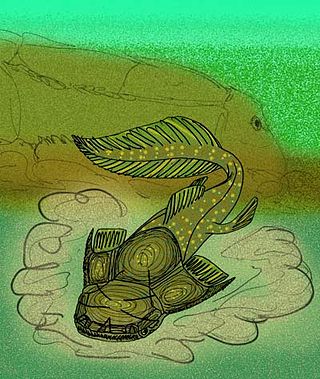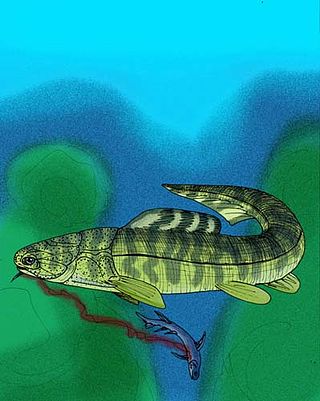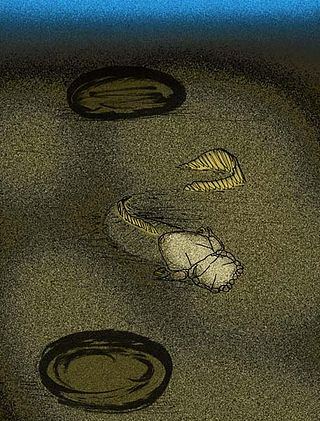
Placodermi is a class of armoured prehistoric fish, known from fossils, which lived from the Silurian to the end of the Devonian period. Their head and thorax were covered by articulated armoured plates and the rest of the body was scaled or naked, depending on the species. Placoderms were among the first jawed fish; their jaws likely evolved from the first of their gill arches.

Phyllolepida is an extinct taxon of flattened placoderms found throughout the world, with fossils being found in Devonian strata. Like other flattened placoderms, the phyllolepids were bottom-dwelling predators that ambushed prey. Unlike other flattened placoderms, the phyllolepids were inhabitants of freshwater environments.

Acanthothoraci is an extinct group of chimaera-like placoderms closely related to the rhenanid placoderms. Superficially, the acanthoracids resembled scaly chimaeras and (relatively) heavily armored ptyctodonts. They were distinguished from chimaeras by their large scales and plates, a pair of large spines that emanate from their chests, tooth-like beak plates, and the typical bone-enhanced placoderm eyeball. They were distinguished from other placoderms by differences in skull anatomy and by patterns on the skull plates and thoracic plates that are unique to this order.

Brindabellaspis stensioi is a placoderm with a flat, platypus-like snout from the Early Devonian of the Taemas-Wee Jasper reef in Australia. When it was first discovered in 1980, it was originally regarded as a Weejasperaspid acanthothoracid due to anatomical similarities with the other species found at the reef.

Lunaspis is an extinct genus of armor-plated petalichthyid placoderm fish that lived in shallow marine environments of the Early Devonian period, from approximately 409.1 to 402.5 million year ago. Fossils have been found in Germany, China and Australia. There are three different identified species of within the genus Lunaspis: L. broilii, L. heroldi, and L. prumiensis.

Phyllolepis is the type genus of Phyllolepida, an extinct taxon of arthrodire placoderm fish from the middle to late Devonian. The species of Phyllolepis, themselves, are restricted to the Famennian-aged freshwater strata of the Late Devonian, around 360 million years ago. Fossils of this genus have been found primarily in Europe and North America. The end of the Devonian saw them disappear in a mass extinction.
Gavinaspis is a phyllolepid placoderm which lived during the Early Devonian period, of Qujing, Yunnan province, south China.

Phlyctaenius is an extinct genus of placoderm fish, which lived during the Devonian period of New Brunswick, Canada. It was named by Traquair (1890) as a replacement for Phlyctaenium Zittel (1879), which was preoccupied.

Phyllolepididae is one of two families of phyllolepid placoderms. The family, as a whole, is believed to be descended from the Chinese placoderm, Gavinaspis (which forms the other, monotypic family, "Gavinaspididae"). All but two genera are, more or less, restricted to freshwater habitats of the Early to Middle Devonian of Australia. By the Frasnian, the genus Placolepis would spread throughout the world, with fossils being found in Australia, Turkey, Venezuela, and Antarctica, and by the start of the Famennian, phyllolepids would become extinct in Australia, with only species of Phyllolepis surviving in freshwater environments of Europe and North America.

Buchanosteus is an extinct genus of arthrodire placoderm. Its fossils have been found in Early Devonian-aged marine strata throughout Asia and Australia. It contains the following species:

Buchanosteidae is a family of arthrodire placoderms that lived from the Early to Middle Devonian. Fossils appear in various strata in Russia, Central Asia, Australia, and China.

Errolosteus goodradigbeensis is an extinct buchanosteid arthrodire placoderm. Its fossils have been found in Emsian-aged marine strata of New South Wales, Australia.

Parabuchanosteus murrumbidgeensis is an extinct buchanosteid arthrodire placoderm. Its fossils have been found in the Late Emsian-aged marine strata of New South Wales, Australia.

Taemasosteus is an extinct genus of arthrodire placoderm. Its fossils have been found in Emsian-aged marine strata in New South Wales, Australia. It contains two species, T. novaustrocambricus, and T. maclartiensis.

Goodradigbeeon is an extinct genus of buchanosteid arthrodire placoderm. Its fossils have been found in Emsian-aged marine strata from the Taemas-Wee Jasper reef of New South Wales, Australia and the type species is G. australianum.

Placolepis is an extinct genus of phyllolepid placoderm first discovered in New South Wales. Placolepis was the most widespread phyllolepid genus, with fossils found in Australia, Turkey, Venezuela and Antarctica.

Yurammia is a placoderm from what is now the Pambula River in New South Wales. Unlike all other known phyllolepids, Yurammia's plates had no external grooves.
Cobandrahlepis is an extinct genus of phyllolepid placoderm found in New South Wales, Australia.

Africanaspis is an extinct genus of groenlandaspidid placoderm known from two species, Africanaspis doryssa, named in 1997 from fossils discovered in South Africa and Africanaspis edmountaini, named from fossils described from South Africa during 2017. A. edmountaini is only known from juvenile specimens. Both species are known from the Witpoort Formation. A. doryssa is estimated to have been 23–24.5 cm (9.1–9.6 in) long.
























